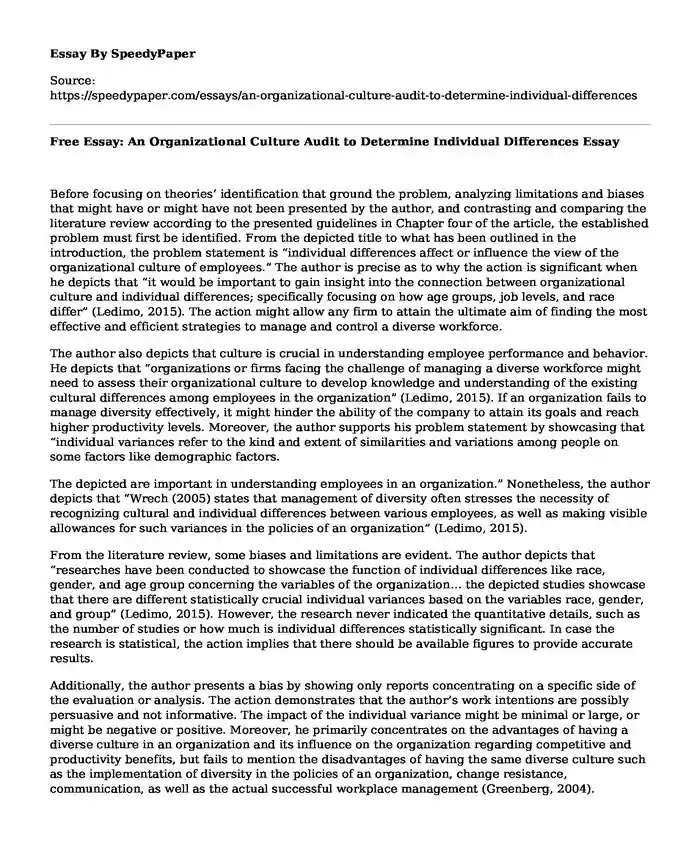
| Essay type: | Problem solution essays |
| Categories: | Human resources Diversity Organizational culture Interpersonal communication |
| Pages: | 4 |
| Wordcount: | 862 words |
Before focusing on theories’ identification that ground the problem, analyzing limitations and biases that might have or might have not been presented by the author, and contrasting and comparing the literature review according to the presented guidelines in Chapter four of the article, the established problem must first be identified. From the depicted title to what has been outlined in the introduction, the problem statement is “individual differences affect or influence the view of the organizational culture of employees.” The author is precise as to why the action is significant when he depicts that “it would be important to gain insight into the connection between organizational culture and individual differences; specifically focusing on how age groups, job levels, and race differ” (Ledimo, 2015). The action might allow any firm to attain the ultimate aim of finding the most effective and efficient strategies to manage and control a diverse workforce.
The author also depicts that culture is crucial in understanding employee performance and behavior. He depicts that “organizations or firms facing the challenge of managing a diverse workforce might need to assess their organizational culture to develop knowledge and understanding of the existing cultural differences among employees in the organization” (Ledimo, 2015). If an organization fails to manage diversity effectively, it might hinder the ability of the company to attain its goals and reach higher productivity levels. Moreover, the author supports his problem statement by showcasing that “individual variances refer to the kind and extent of similarities and variations among people on some factors like demographic factors.
The depicted are important in understanding employees in an organization.” Nonetheless, the author depicts that “Wrech (2005) states that management of diversity often stresses the necessity of recognizing cultural and individual differences between various employees, as well as making visible allowances for such variances in the policies of an organization” (Ledimo, 2015).
From the literature review, some biases and limitations are evident. The author depicts that “researches have been conducted to showcase the function of individual differences like race, gender, and age group concerning the variables of the organization… the depicted studies showcase that there are different statistically crucial individual variances based on the variables race, gender, and group” (Ledimo, 2015). However, the research never indicated the quantitative details, such as the number of studies or how much is individual differences statistically significant. In case the research is statistical, the action implies that there should be available figures to provide accurate results.
Additionally, the author presents a bias by showing only reports concentrating on a specific side of the evaluation or analysis. The action demonstrates that the author’s work intentions are possibly persuasive and not informative. The impact of the individual variance might be minimal or large, or might be negative or positive. Moreover, he primarily concentrates on the advantages of having a diverse culture in an organization and its influence on the organization regarding competitive and productivity benefits, but fails to mention the disadvantages of having the same diverse culture such as the implementation of diversity in the policies of an organization, change resistance, communication, as well as the actual successful workplace management (Greenberg, 2004).
The literature review follows the guidelines presented in chapter four of the textbook. As depicted by Sekaran and Bougie (2016), “the effort of the research is relatively positioned to the existing knowledge and builds on the same knowledge,” “one can look at a challenge from a particular angle,” “its definition and relevant terms were introduced, as it was more of a descriptive or informative element there was less rediscovery to be conducted,” and “it sparks important insights on the topic and shapes one’s thinking” (Ledimo, 2015). The effort relies on factual data and continues to build on the depicted knowledge through investigations and referencing studies conducted.
Moreover, the problem is established where one can see that “there are important statistic individual variances regarding the views of the participants of the organizational culture” (Sekaran & Bougie, 2016). Pertinent terms are defined and presented including the organizational culture concept as well as its different definitions, diversity definition, the general culture with what it is made up of, as well as various organizational culture typologies.
The depicted are all presented in a creative and informative way that causes reshaping of a person’s thinking and provides them with new insights regarding the topic. The action is relevant especially when it addresses the secondary and primary dimensions of individual variances and their impacts on every person or employee. Additionally, quotation and referencing in the section of the literature review are present with no discrepancies which depict that no elements are lacking on the piece.
References
Greenberg, J. (2004). Diversity in the workplace: benefits, challenges, and solutions. The multicultural advantage. http://www.multiculturaladvantage.com/recruit/diversity/diversity-in-the-workplace-benefits-challenges-solutions.asp
Ledimo, O. (2015). Diversity management: An organisational culture audit to determine individual differences. Journal of Applied Business Research (JABR), 31(5), 1733-1746. https://doi.org/10.19030/jabr.v31i5.9388
Sekaran, U., & Bougie, R. (2016). Research methods for business: A skill building approach. John Wiley & Sons. ISBN: 978-1-1191-655-2
Cite this page
Free Essay: An Organizational Culture Audit to Determine Individual Differences. (2023, Sep 27). Retrieved from https://speedypaper.com/essays/an-organizational-culture-audit-to-determine-individual-differences
Request Removal
If you are the original author of this essay and no longer wish to have it published on the SpeedyPaper website, please click below to request its removal:
- Forgiveness Essay Example
- Essay Example: Invisible Members in Our Society According to Orwell
- Free Essay with Rhetorical Analysis of the Article Dedicated to Game Violence
- Free Essay Example. Perspectives in History
- Free Essay Example - Hindu Temples
- Essay Example: Ethics, Compliance Auditing and Emerging Issues
- Free Essay - Six Thinking Hats in Systems Engineering
Popular categories




